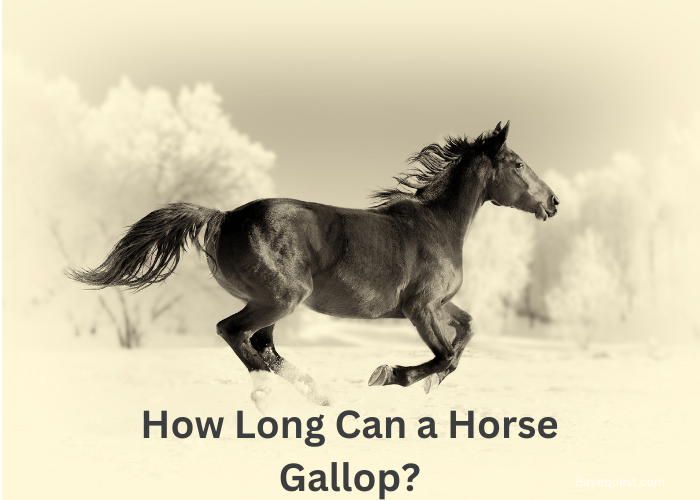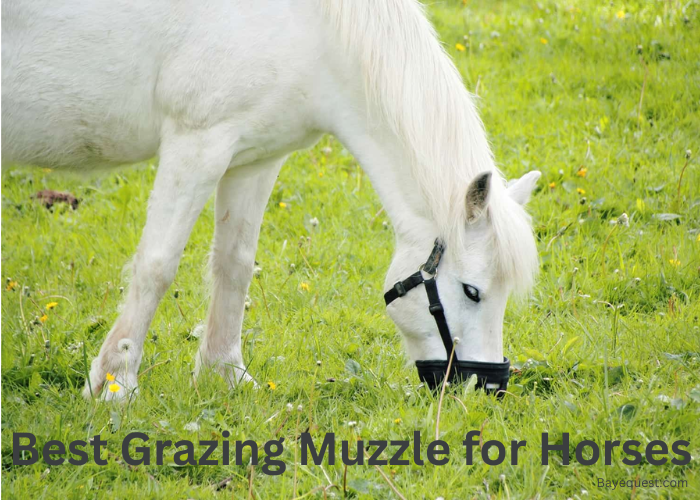Horses galloping at full tilt is the epitome of untamed energy, yet even these powerhouses have a breaking point.
With years of equine care and training, I’ve learned the nuances of their endurance. Many riders wonder, ‘How long can a horse gallop?’
This piece sheds light on equine stamina, offering valuable knowledge for optimizing your horse’s health and performance.
Let’s dive into the fascinating world of horse galloping dynamics together.
How Long Can a Horse Run Continuously?
A well-conditioned horse can gallop continuously for 1-2 miles before needing rest. With proper training and conditioning, some can sustain galloping for 2-3 miles. Their ability to gallop longer distances improves with endurance training. This makes them capable of remarkable feats in competitive events.
How Long Can a Horse Gallop Without Stopping?
The average horse can gallop for 2-2.5 miles at full speed without stopping. But remember that top speeds vary from one breed to the next and from one individual horse to another.
Also, the actual speed greatly impacts the distance covered without resting.
For instance, thoroughbreds are extremely fast horses that can cover up to 44 miles per hour. Thus, a thoroughbred horse runs a paltry 3.4 minutes to cover 2.5 miles.
Meanwhile, some ponies can cover only 20 miles in an hour, while a horse would cover 1.3 miles in 3.4 minutes. Therefore, if both horses tire after 3.4 minutes, the thoroughbred wins the contest.
But lower speeds allow horses to run longer without tiring. Therefore, lower-top-speed breeds can cover more than 2.5 miles without resting.
Of course, individual characteristics and conditions also impact the distance covered without resting. For instance, a healthier horse can gallop for longer without resting.
Similarly, historical injuries can impact the horse’s durability.
Finally, the distance covered without resting greatly depends on the environmental conditions, especially altitude, weather, and terrain.
For instance, scientific studies in the Journal of Applied Physiology show that horses can run longer without stopping in colder weather.
Horses also cover more distance on fair terrain. For example, horses tire less fast on a professional racing track.
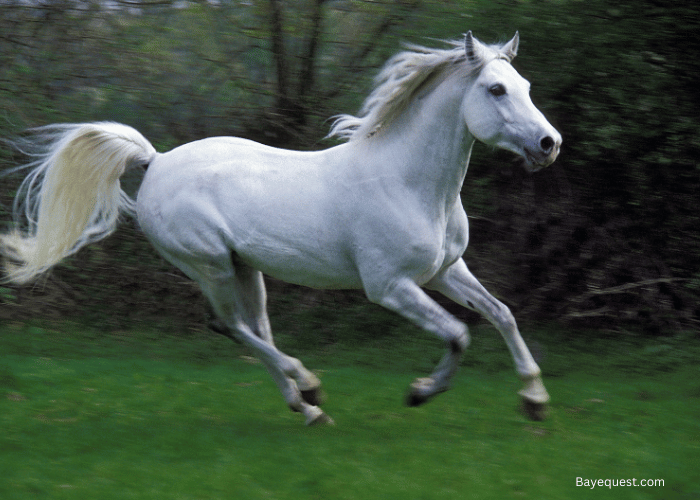
How Far Can a Horse Gallop in One Hour?
With scheduled breaks, a healthy horse can cover 12 miles in an hour at full speed. It depends on the breed, training type, and external elements, such as the weather and terrain.
Again, Arabians are the most enduring and, thus, can cover the most distance in an hour. A healthy, well-trained Arabian easily covers 12 miles in an hour, taking breaks every 2-3 miles.
It covers the most distance at a trot, requiring fewer stops and shorter rests. But it can also run full speed for an hour with well-timed breaks.
Meanwhile, the average ranch horse barely covers any ground. Moreover, ranch horses have poor endurance.
So, they can’t travel long distances at a pace without long rests in between. Your average quarter horse trained for ranch work may only cover 5-7 miles in an hour.
How Far Can a Horse Travel in a Day?
High-endurance horses can cover up to 100 miles (161 km) in a day’s work. However, the average horse can never achieve this feat.
Instead, most horses tire at 20-30 miles and may sustain muscle injuries if they travel longer in 24 hours. Note that 20-30 miles/day is also the optimal range for humans.
The best way to verify this is to follow well-known endurance rides. We recommend the Western States Trail Ride in California and Old Dominion Ride in Virginia.
They are the most popular 100-mile, single-day endurance events in the US.
You’ll note that most full-day endurance riders ride below peak speeds to cover longer distances. Also, achieving this feat requires much training and practice.
When competing in multi-day events, the horse must cover a shorter distance daily. For example, a top endurance horse targeting 100 miles in a 2-day event must not travel more than 62 miles in one day.
Similarly, the horse must not cover more than 50 miles in a day during a 3-day event.
Related read: How Far Can a Horse Travel in a Day?
What Makes Horses Good Runners?
Few animals are faster than horses, even in the wild, because horses are built to run. Their large, powerful hearts pump blood faster and circulate it efficiently, replenishing the horse’s energy effortlessly. Meanwhile, the large lungs enable better breathing, allowing horses to run longer without stopping.
Additionally, the horse’s physical disposition facilitates faster and longer running. Their long, muscular legs are perfect for running. They allow the horse to accelerate without losing stamina.
Moreover, the horse’s legs are light and agile, with no muscles in the lower limbs. This is why a horse’s gallop looks springy. The legs are also elastic to sustain high-speed running.
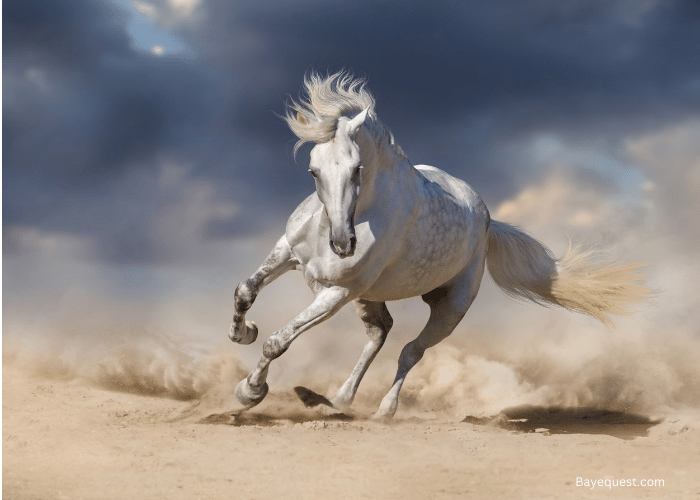
Different Gaits, Different Speeds
There are four main horse gaits: the walk, trot, canter/lope, and gallop, each describing a different speed.
- Walking: The walk is the easiest and most common gait. It involves the animal moving at a walking pace, translating to about 4 miles/hour for the average healthy horse. Your horse will spend most of the day walking as it’s a comfortable gait.
- Trotting: Trotting is slightly faster than walking. But it’s still a comfortable gait for the horse, and you’ll occasionally find the horse playing around at trotting pace. Trotting speeds rarely exceed 8 miles/hour.
- Canter: The canter, also known as a lope, is faster than the trot but slower than a full gallop. It’s the sweet spot for pleasure riders. Yet, it’s the most uncomfortable gait for the horse as the bouncy motion takes a toll on its back and knees. Horses can canter at speeds up to 17 miles/hour.
- Gallops: The gallop is the horse’s top speed. That’s why most people call it the “run.” It consumes lots of energy, tiring the horse quickly. However, gallops are comfortable for the horse over the first few miles. The speeds can reach 30 miles/hour.
Galloping Vs Other Gaits
So, we’ve seen that a horse can gallop for 2-2.5 miles at top speed (often up to 40 miles per hour). But what about the other gaits? How long do horses walk, trot, or canter without resting?
How long can a horse walk?
The most enduring horses can walk 30-32 (48 to 51.5 km) daily with regular rest and rehydration breaks. But they can easily cover 7-10 miles without resting. Again, the distance depends on the breed and walking pace. Faster walks are more tiring, while slower walks allow the horse to last longer before breaking.
How long can a horse trot?
Highly trained trotting horses can cover 20-40 miles daily with regular breaks. That’s equivalent to 32-64.5 kilometers. However, this applies to only a few high-endurance breeds. The rest cannot trot more than 10 miles daily as it’s a taxing gait. They can trot for 5-7 miles without breaking.
How long can a horse canter?
Horses can canter for 3-5 miles without stopping, though a few sometimes reach seven miles without a break. Highly trained special breeds give the best results. Meanwhile, the average riding horse cannot canter more than three miles without breaking to rest and rehydrate.
A Little About Endurance Racing
Equine endurance racing has a whole sport named after it, known as endurance racing. You can use these events to estimate the longest distance a horse can gallop without resting.
The races cover 50 to 100 miles, but shorter races, typically 10 and 25 miles, are available for beginners.
The records show that only the best racehorses often cover 2-2.5 miles (3.2 to 4.0 km) in full gallop without stopping.
The Arabian is often on top, followed by thoroughbreds and Anglo-Arabian breeds. But even then, only a few individuals within the breeds reach this incredible feat.
Stockier breeds, especially draft horses, are excellent short-distance runners. But they tire quickly. So, they may only cover a mile or two before tiring.
Interesting read: Is Horse Riding a Sport or a Hobby?
Horse Breeds with the Highest Endurance
The Arabian is your best bet when shopping for an endurance horse. Originating from the harsh desert conditions of the Middle East, Arabian horses are adapted to difficult weather, challenging terrain, and extreme heat and temperature changes. So, they take to endurance events like a duck to water.
An Arabian horse can reach a top speed of 34-40 mph, equivalent to 55-64.5 km/hour. More impressively, they can run long without rest and even longer over a few hours or days with good rest.
As a result, Arabians have dominated the Tevis Cup’s 100-mile race, the US’s most testing endurance event, for 23 years.
Thoroughbreds come a distant second. They are faster than Arabians over short distances, clocking up to 44 mph (71km/h) in various contests. However, they’re less enduring than Arabians over long distances, needing more frequent rests.
Arabian-Thoroughbred crosses, known as Angle-Arabians, provide the best of both worlds. They are faster than Arabians over short distances and more enduring than thoroughbreds over long distances.
Though the price of an Arabian horse may be on the higher end, it is such a nice investment.
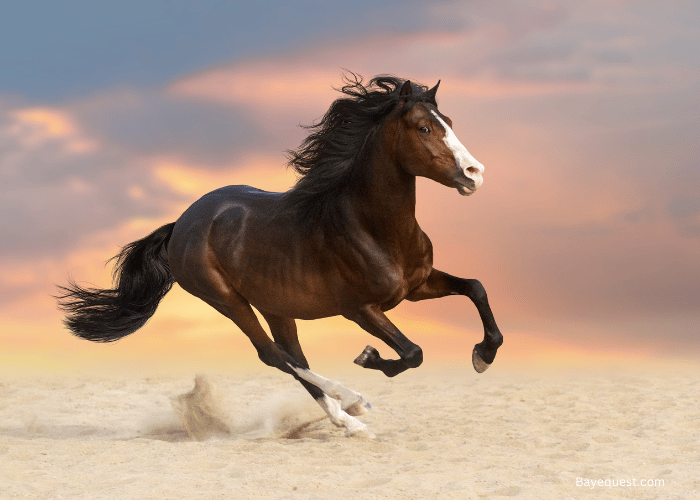
Dangers of Overextending Your Horse
Endurance racing is among the most exhilarating sports, drawing millions of viewers annually. But you must never overextend the horse merely for the thrill. It carries huge dangers.
Injuries are the first major concern. Just like in humans, brisk pace gallops over long distances strain the muscles, tendons, and ligaments, often resulting in soreness and swelling. Or worse, the horse may suffer hoof or bone damage, causing lameness.
The next major concern is dehydration. Horses lose lots of water when they run over long distances without rehydrating. This can cause fatigue, muscle cramps, and colic.
Finally, and most importantly, endurance sports increase the risk of cardiovascular issues. The training forces the body to adapt by developing increased capillary density.
Alternatively, the heart must begin pumping more blood (beyond allowable levels) with each beat.
Such changes can result in abnormal heart rhythms, heart scarring, and ultimately, calcium-rich plaques in the arteries, increasing the risk of heart failure and eventual death.
See also: Average Horse Heart Size.
How to Care for an Endurance Racing Horse
Endurance horses need special care to run or walk longer within a shorter time. A special care program also prolongs the horse’s life.
Begin by ensuring a proper diet. An endurance horse’s diet comprises quality forage to provide enough energy. Additionally, a well-balanced diet comprising carbohydrates, proteins, vitamins, and fats ensures good health and optimal nutrient uptake.
Also, remember to provide plenty of fresh water to prevent dehydration. Depending on the breed and size, horses drink 4-10 gallons of water daily.
Besides feeding and watering, ensure adequate training to prepare the horse for the grueling conditions. Proper training builds the horse’s endurance while also improving strength and fitness. Moreover, it boosts flexibility, reducing the risk of joint and muscle injuries.
The best approach is to begin with basic training and gradually intensify the schedule. This reduces the risk of overtraining.
Finally, a practical rest and recovery plan goes a long way. Adequate rest allows the body to recover. More importantly, the body uses the opportunity to repair broken tissues in preparation for the next endurance event.
Interesting read: Types of Horse Competitions.
How Fast Do Horses Run? FAQs
How fast can horses run with a rider?
Racehorses can reach neck-breaking speeds of 74km/hour over short distances when running without extra load. However, even the best horses only reach 32-48.5 km/hour with a rider on their back, lasting at most 3km before resting.
What’s the average racehorse speed?
The average horse runs 10 to 17 miles per hour, equivalent to 16-27 km/hour. However, the speeds improve drastically with training. For example, a moderately trained horse can clock 25-30 miles per hour, equivalent to 42-48 km/hour. Unsurprisingly, some horses cannot cover more than 10 miles in an hour.
What’s the fastest horse breed?
The thoroughbred is the fastest horse breed and the most common racing horse. The Winning Brew, a thoroughbred born in 2008, holds the Guinness Record for the fastest horse. He clocked a staggering 70km/hour, a feat no other horse has ever managed.
How Fast Does a Horse Run? Summary
Horses have four gaits: the walk, trot, canter, and gallop. Walks are the slowest, while gallops are the fastest.
Professional endurance racehorses can gallop 2-2.5 miles at top speed without resting. However, regular horses often tire after 1-1.5 miles.
Also, read our other article on gaited horse breeds to learn more about horses with unique, smooth gaits that make riding a breeze.




